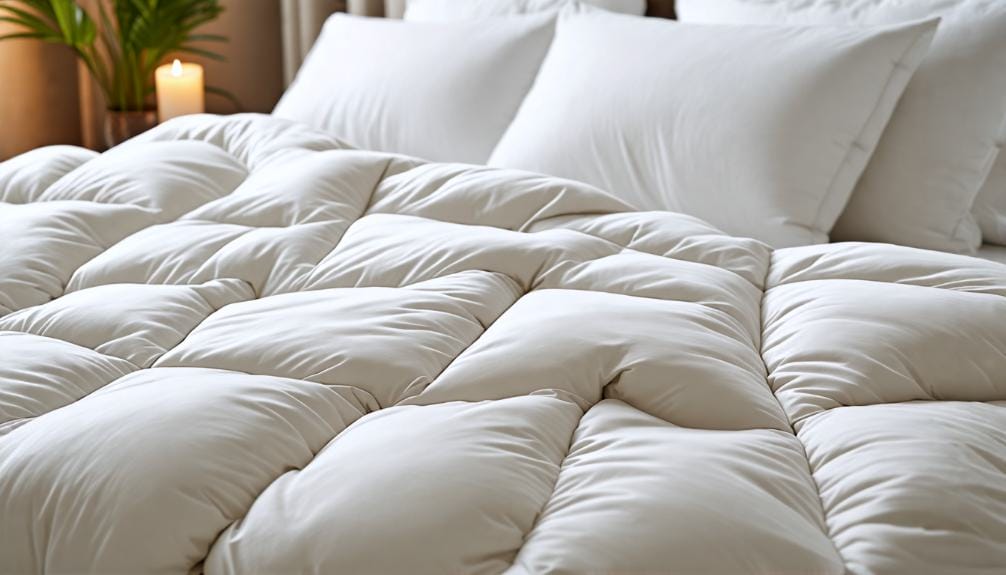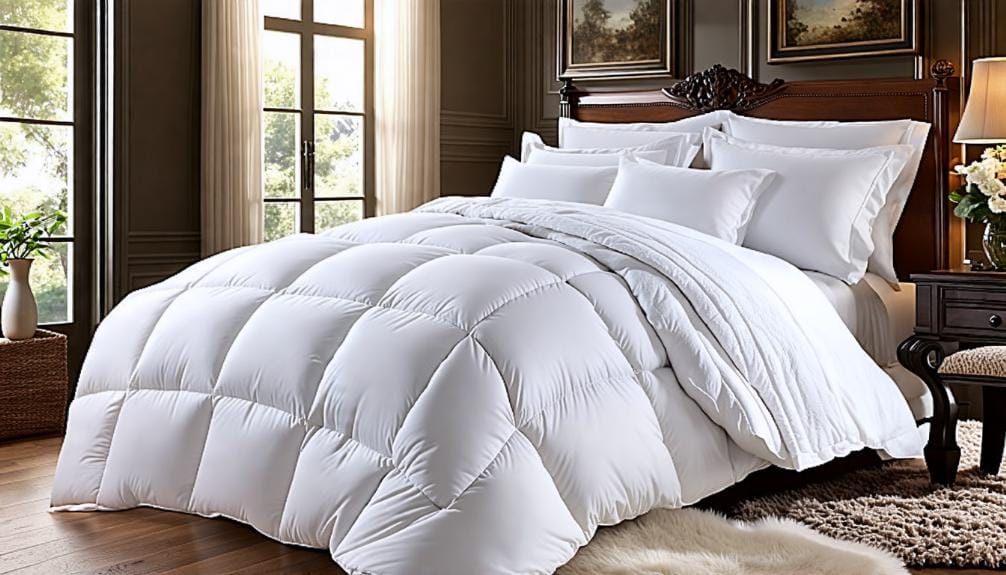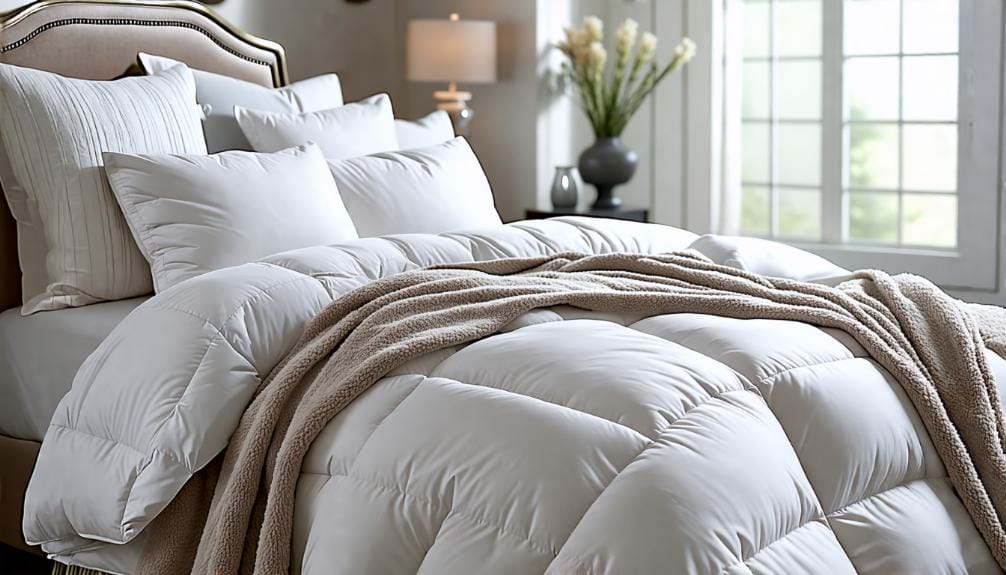Down Alternative Vs Down Comforter: Which Is Best?
When you are deciding between a down comforter and a down alternative, you might find yourself weighing various factors like warmth, comfort, and ethical considerations. Down comforters are known for their luxurious feel and exceptional insulation, but they often come with concerns about animal welfare. On the other hand, down alternatives promise a hypoallergenic and budget-friendly solution, appealing to those with allergies or a preference for sustainable choices. So, which option aligns best with your needs? The answer might surprise you as we explore the nuances of each.
What is a Down Comforter?

A down comforter is a top-tier bedding option filled with the soft feathers of geese or ducks. It’s designed to offer exceptional warmth while being lightweight, making your sleep experience cozy and comfortable.
The key to its effectiveness is its high fill power, which traps air efficiently and provides excellent insulation. This results in a fluffy, cloud-like feel that many people find incredibly comfortable.
Pay attention to the fill power rating when shopping for a down comforter. Higher fill power means better insulation and a greater warmth-to-weight ratio, so you get the warmth without the bulk.
Unlike synthetic down-alternative comforters, down comforters excel in breathability and temperature regulation, which can help you sleep better.
However, down comforters may not be suitable for everyone. If you have allergies or ethical concerns about using animal products, a down-alternative comforter might be a better fit.
Your decision will ultimately depend on your preferences regarding warmth, comfort, and lifestyle needs.
What is a Down Alternative Comforter?
Down alternative comforters are a great option for those who want the comfort and warmth of traditional down without the allergens. Made from synthetic materials like polyester, they’re ideal for people with allergies.
Key features of down alternative comforters include:
- Hypoallergenic: These comforters are designed to minimize allergic reactions by resisting dust mites and mold, making them a good choice for allergy sufferers.
- Lightweight Fill Material: The synthetic fibers offer warmth and breathability, catering to different sleep preferences.
If you’re looking for a cozy, easy-to-maintain bedding option that’s also hypoallergenic, a down alternative comforter might be just what you need.
How Do Down and Down Alternative Comforters Compare in Warmth?

Comparing the warmth of down comforters and down alternative comforters shows clear differences in insulation and weight.
Down comforters are excellent at retaining warmth while being lightweight, thanks to their natural insulating properties. Sleeping under a down comforter often feels like being wrapped in a soft, warm cloud, making them ideal for colder temperatures. This superior warmth can be a game-changer on chilly nights.
On the other hand, down alternative comforters, made from synthetic materials, usually need more weight to match the warmth of down. This can result in a bulkier blanket that some people might find stifling. However, if you tend to sleep hot, a down alternative might offer better temperature regulation, providing a more comfortable night’s sleep without overheating.
Ultimately, your choice depends on what you value more. If you prioritize lightweight warmth and a luxurious feel, down comforters are hard to beat. But if you’re looking for a heavier option or need something more breathable, down alternatives could be a better fit.
Understanding these warmth differences can help you make a smart choice that fits your sleeping needs.
Which is Better for Allergies: Down or Down Alternative?
For people with allergies, down alternative comforters are often a better choice due to their ability to resist dust mites and mold. Traditional down can trap allergens, while down alternatives use synthetic fill that’s hypoallergenic. This makes them a practical option for those dealing with allergies.
Here are a few reasons why down-alternative comforters might be healthier:
- Dust Mite Resistance: Synthetic materials in down alternatives deter dust mites, which are common allergens.
- Mold Prevention: These comforters are less likely to harbor mold spores, making them great for humid environments.
Using down-alternative comforters lets you sleep peacefully without worrying about triggering allergies. You can enjoy a cozy and comfortable night’s sleep while maintaining a healthier sleep environment. If you’re sensitive to allergens, down alternatives offer both comfort and health benefits.
What are the Environmental Impacts of Each Option?

Choosing between down and down alternative comforters involves considering their distinct environmental impacts, which can greatly influence your decision. Down comforters, while luxurious, often raise ethical concerns regarding animal welfare and sourcing. The harvesting of down can involve stress on the birds, leading to questions about sustainability. In contrast, down alternatives made from synthetic fibers may not involve animal cruelty, but their production can contribute to pollution and waste.
Here’s a quick comparison to help you weigh the environmental impacts:
| Category | Down Comforter | Down Alternative |
|---|---|---|
| Sourcing | Animal-based, ethical concerns | Synthetic, less ethical concerns |
| Biodegradability | Biodegradable | Non-biodegradable |
| Carbon Footprint | Higher due to farming | Varies with materials used |
| Allergen Resistance | Less allergenic | More allergenic resistance |
| Sustainability | Questionable | Varies by manufacturer |
Ultimately, your choice should reflect your values regarding sustainability and ethical implications. Each option has trade-offs, so consider what matters most to you.
How Do Aesthetics Differ Between Down and Down Alternative Comforters?
Aesthetics play a key role in the appeal of down and down alternative comforters, shaping how they contribute to your bedroom’s overall design. As you look at bedding options, the visual impact is often as crucial as comfort.
- Visual Texture: Down comforters usually have a lush, fluffy texture that adds warmth and luxury to your space.
- Design Versatility: Down alternatives often come in a wider range of vibrant colors and patterns, allowing for more customization to fit your personal style.
Down comforters create an inviting, cozy atmosphere, while down alternatives can provide unique aesthetics that align with contemporary design preferences.
The choice hinges on your personal taste and how you wish to express your style through bedding. Whether you lean toward the classic elegance of down or the modern flair of down alternatives, both can elevate your bedroom’s design in distinct ways.
What Should You Consider Before Making a Purchase?

Before buying, think about what makes you comfortable since it affects how well you sleep.
Consider your budget and how much you’re willing to spend.
Also, take into account any ethical or health concerns, especially if you have allergies or care about sustainability.
Personal Comfort Preferences
Deciding between a down and down alternative comforter hinges on your personal comfort preferences. Here’s what to consider:
- Allergies: If you have allergies, go for a down alternative. These are often hypoallergenic and resistant to dust mites, making them a healthier option.
- Warmth and Weight: Think about whether you prefer the lightweight, airy feel of a down comforter or the heavier, cozier warmth of a down alternative.
Your choice should reflect your lifestyle and values.
If you crave the luxurious warmth and feel of a down comforter, it might be worth the splurge.
On the other hand, if allergies or sustainability are key concerns, a down alternative could be a better fit.
Budget Considerations
When deciding between down and down alternative comforters, it’s crucial to consider your budget since prices can differ greatly depending on the material and brand. Down comforters tend to be more expensive due to their luxurious fill, whereas down alternatives usually provide more affordable options without skimping on comfort.
Here’s a quick comparison to help you make an informed choice:
| Comforter Type | Price Range | Key Features |
|---|---|---|
| Down Comforters | $150 – $500+ | Luxurious feel, high warmth |
| Down Alternatives | $50 – $250 | Budget-friendly, allergen resistance |
| Synthetic Material | $30 – $150 | Lightweight, easy to maintain |
| Premium Down | $300 – $800+ | Superior quality, longer lifespan |
| Budget Down | $100 – $200 | Affordable, decent warmth |
Consider how much you value allergen resistance and durability when planning your budget. If you’re tight on funds but need allergen resistance, down alternatives made from synthetic materials might be the best pick. Knowing your financial limits will help you find the perfect comforter for your needs.
Ethical and Health Considerations
Making an informed choice about your comforter can significantly impact both your well-being and your ethical stance. Here are some key points to consider:
- Ethical considerations: Pay attention to where the materials come from. Down comforters are made using feathers from birds, which raises issues about animal welfare. If humane practices are important to you, a down alternative might be a more ethical option.
- Health considerations: If you have allergies, down alternatives are often better at resisting allergens like dust mites and mold. This can lead to better sleep quality.
Your comforter choice should align with your comfort needs and personal values.
Weigh the luxury of down against the health benefits and ethical considerations of down alternatives.
Whether you prefer the plush feel of down or the hypoallergenic benefits of a down alternative, being well-informed will help you make the best decision for your lifestyle.
Frequently Asked Questions
How Do I Properly Care for My Down Comforter?
To care for your down comforter, you should regularly fluff it to maintain its loft. Wash it gently in a large machine using mild detergent, and dry it thoroughly on low heat with tennis balls for best results.
Can Down Alternative Comforters Be Washed in a Machine?
Yes, you can wash down alternative comforters in a machine. Just use a gentle cycle with cold water and a mild detergent. Make sure to dry them thoroughly to maintain their fluffiness and prevent clumping.
What Is the Lifespan of Down Vs. Down Alternative Comforters?
Down comforters typically last 10-15 years with proper care, while down alternatives usually last 5-10 years. Your choice affects longevity, so consider maintenance and usage when deciding which one suits your needs better.
Are There Any Specific Brands Known for Quality Down Alternatives?
While you’re searching for quality down alternatives, check out brands like Brooklinen, Snowe, and Saatva. They offer excellent hypoallergenic options that provide comfort and warmth without compromising on style or sustainability.
How Do I Choose the Right Fill Power for a Down Comforter?
When choosing the right fill power for your down comforter, consider your warmth preferences and sleeping climate. Higher fill power offers more warmth with less weight, while lower fill power may feel heavier but still provides comfort.
In Conclusion
In the end, choosing between a down and a down alternative comforter comes down to your personal preferences and lifestyle.
If you value luxury and warmth and don’t mind the ethical concerns, a down comforter might be your best bet.
However, if you’re looking for a budget-friendly, hypoallergenic option that’s easier to maintain, a down alternative could be the way to go.
Consider your needs, and you’ll find the perfect comforter for your cozy nights!
